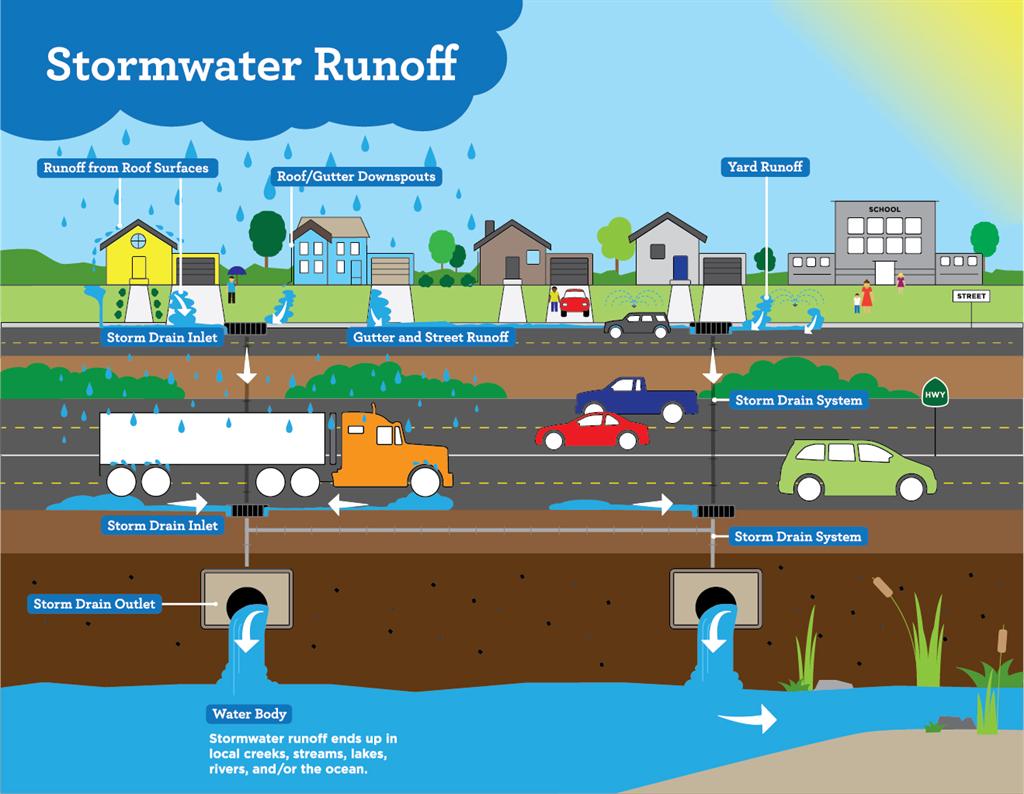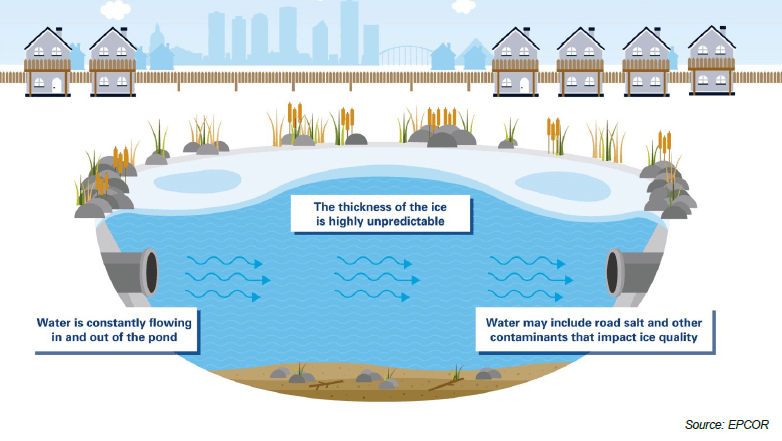
Stormwater is the rain and melted snow that flows from local properties onto the street and into storm drains. It eventually ends up in Ontario’s lakes.
Stormwater infrastructure protects our water quality and helps lower the risk of flooding. In Middlesex Centre, our stormwater infrastructure includes stormwater ponds, storm sewers, catch basins, maintenance holes, oil grit separators, culverts and municipal drains.
Climate change, aging infrastructure, new residential development and other factors put pressure on our stormwater infrastructure. To protect local property and the environment, we need to invest money in stormwater infrastructure.
VIDEO: Stormwater Management in Middlesex Centre
- What is stormwater management?
-
Stormwater management involves storing and directing stormwater runoff in urbanized areas to control flooding, erosion and water quality. This practice protects communities, municipal infrastructure (like roads, sidewalks and trails) and local waterways. The objective of stormwater management is to slow the release of stormwater runoff into natural systems.
One way of managing stormwater runoff is through the use of stormwater ponds. Stormwater ponds can be ‘dry’‐ filling up during a storm, or ‘wet’ - having a permanent pool of water. These ponds are designed to hold back stormwater and release it slowly to natural waterways. Wet ponds also allow sediment to settle to the bottom of the pond instead of traveling to a local stream. Stormwater ponds do require maintenance to keep them working properly, such as sediment removal or cleaning of catch basins. Sometimes older ponds need to be replaced with newer, more efficient designs.
- Why is stormwater management important?
-
Without stormwater management, runoff from urbanized areas would flood communities and roads, cause stream erosion and destroy aquatic habitat. Lakes and local streams also suffer from runoff, Stormwater that rushes uncontrolled from urban pavements causes streams to rise faster and more dangerously than those in rural areas. The force of the water during rain events scours stream bottoms, erodes banks, harms fish habitat and increases pollutants such as phosphorus and heavy metals. Stormwater picks up dirt, oil, grease, road salt, fertilizers, pesticides and bacteria from urbanized areas. During its journey over pavements, stormwater also becomes warmer which is harmful to fish
Stormwater management is required to release runoff into natural waterways slowly, imitating the water cycle before urbanization. Stormwater ponds are also important because they provide an opportunity for sediment (and pollutants attached to the sediment) to become trapped in the pond bottom, rather than moving into the local streams.
- What is Middlesex Centre's role in stormwater management?
-
The Municipality of Middlesex Centre is responsible for planning adequate stormwater control for existing and new communities along with operating and maintaining these systems. The Municipality must ensure the stormwater system is operating in accordance with various acts, regulations and approvals provided by federal, provincial and local authorities
- What is Middlesex Centre's Stormwater Master Plan?
-
Middlesex Centre Settlement Area - Stormwater Master Plan
The Stormwater Master Plan considers all aspects of the environment in order to develop a holistic plan for managing stormwater infrastructure. It is an important resource for the municipality as we continue to adapt to growth and changing environmental conditions and regulations.
The Master Plan reviews existing drainage conditions within settlement areas, develops and evaluates alternative solutions, and identifies recommendations to address existing and future conditions.
- Stormwater Master Plan - Executive Summary
- Stormwater Master Plan - Full Report
-
- Middlesex Centre Settlement Area Stormwater Master Plan
- Appendix A - Consultation
- Appendix B - Figures
- Appendix C - Official Plan Schedules
- Appendix D - Evaluation of Alternative Solutions
- Appendix E - Supplementary Information
- Middlesex Centre Settlement Area Stormwater Master Plan
- Stormwater Master Plan - Update (Oct. 2023)
- Delaware Area Stormwater Master Plan
-
- Delaware Community Settlement Area Stormwater Master Plan (completed separately)
- Why is there a charge for stormwater management?
-
A comprehensive review completed in early 2016 found that Middlesex Centre needed an equitable, dedicated and stable source of funding for stormwater infrastructure. The stormwater charge will allow us to invest in this infrastructure now so that it will be better able to adapt to challenges today and over the long term.
The Stormwater Management Rate is a dedicated source of funding for our stormwater infrastructure. It is a monthly charge applied to all properties situated within one of the Municipality’s settlement urban growth boundaries as defined by the Official Plan (refer to map schedules at end of Official Plan).
All properties located in the settlement areas, regardless of the type, pay a monthly fee for stormwater management services. Properties above 0.4 hectares (1 acre) in area, contribute an additional fee per hectare.
Water, Wastewater and Stormwater Fee Flyer
Please note these fees are reviewed by Council annually, and are subject to change.
- Where are stormwater ponds in Middlesex Centre?
-
You can find stormwater ponds in communities across Middlesex Centre.
Depending on where they are located, maintaining the stormwater pond may be the responsibility of the municipality, developer, or private landowner. If they are the responsibility of the municipality, we say they are "assumed."
- Deerhaven Park, Ilderton – assumed
- Meadowcreek, Ilderton – assumed
- Union Ave., Komoka – assumed
- Jefferies Rd., Kilworth – assumed
- Wynfield Gate/Wynfield Lane, Melrose – assumed
- Caverhill (Caverhill Park), Komoka – currently unassumed (expected to be assumed in 2022)
- Clear Skies, Ilderton – currently unassumed
- Edgewater Estates, Kilworth – currently unassumed
- Timberwalk, Ilderton – currently unassumed
- Robert St., Ilderton – private
Regardless of whether or not a stormwater pond has been assumed by the municipality, for your safety avoid all activities that require contact with or use of water or ice in a stormwater pond.
- Why can't I skate, fish or play in a stormwater pond?
-
Stormwater management ponds are designed to gather rainfall and surface water runoff and temporarily hold this water, releasing it slowly at a controlled rate. This provides erosion and flood control and helps improve surface water quality.
While you might enjoy a stroll around a stormwater pond, please remember that all activities that require contact with or use of water or ice in the stormwater ponds are prohibited at all times.
- In the warmer weather, rainwater will move any contaminates from roadways in to the ponds, and water levels can change suddenly without notice. This makes playing (swimming, fishing, etc.) in or at the edge of the ponds unsafe.
- In the winter, the water going into the ponds, including melting snow and ice, may contain salt and other contaminants that can make any ice that forms unstable and dangerous. The ponds are not safe for winter activities like ice skating, hockey and sledding, or even for walking across.
Please stay safe - obey posted signs and stay off stormwater management ponds.
- How can I help protect our waterways?
-
Everyone can help reduce the amount of stormwater runoff. Try these tips to reduce your stormwater ‘footprint’, lower your water bill, and conserve water:
- Use a car wash instead of your driveway to wash your car. This will decrease the mixture of wash water and sediment entering storm sewers. Clean up animal waste, grass clippings and fallen leaves from your property regularly.
- Be careful to not over‐fertilize your lawn as excess nutrients can enter the stormwater system.
- Have your car fixed if it is leaking fluid. Oil and other vehicle fluids can be very harmful to fish and wildlife reliant on our streams, rivers and lakes.
- Use rain barrels to capture roof runoff and use this water on your lawn and gardens.
- Disconnect your roof downspout if it is connected to a storm sewer. You can either connect it to a rain barrel or have it directed onto your lawn. Use water from rain barrels to water your lawn or gardens.
- Manage your use of road salt and sand in the winter. During snow melt periods, salt and sand will enter the storm sewer system and can have negative impacts downstream.
- Dispose of household hazardous waste properly, not down a storm drain.
- Choose plants that are drought tolerant and do not need to be watered as often.
- Check your sprinkler system for leaks and ensure you are only watering your lawn on days and times allowed. The best times to water your lawn and garden are in the early morning or late evening.
Related Documents

